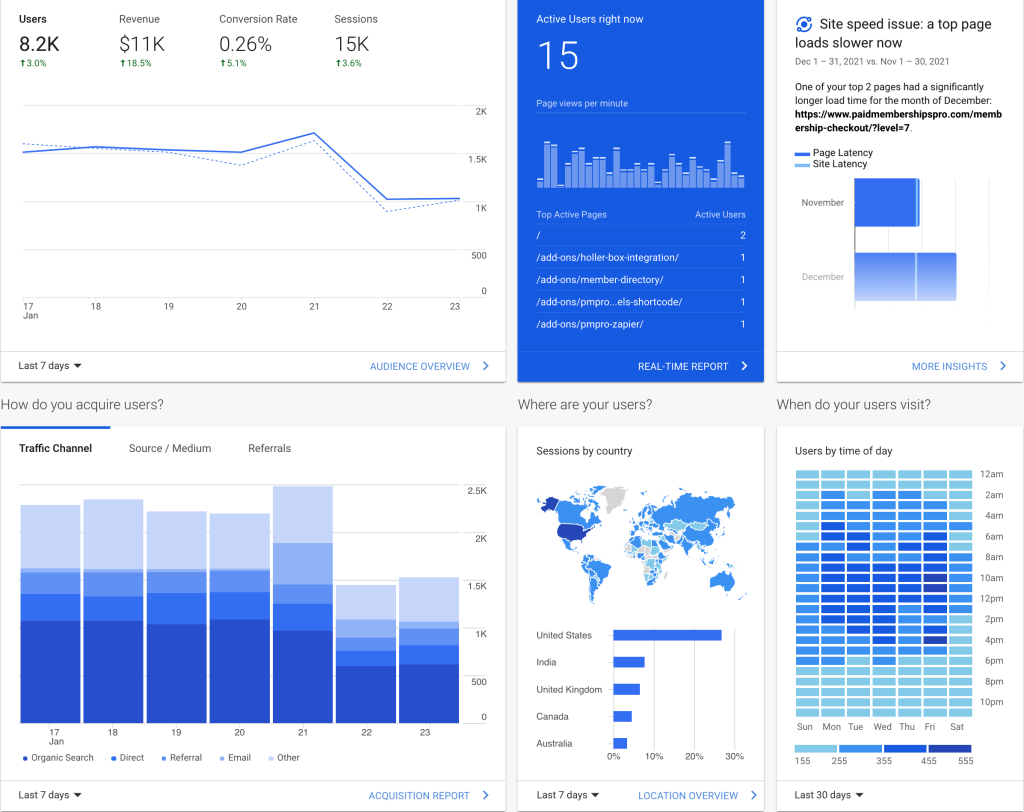Running a membership site can be extremely rewarding. You get personal satisfaction from sharing your knowledge and expertise. It allows you to grow a community of like-minded individuals pursuing the same goals. Additionally, it can bring freedom and financial stability to your life.
However, sometimes it’s easy to get lost in the excitement and forget to check whether or not your efforts are producing real results.
Measuring your membership site’s long-term performance can inform your decisions across all areas of your business, from marketing to site content, but what should you measure?
Key Performance Indicators (or KPIs) can tell you if your membership site is doing well or not. Keep reading as we discuss the KPIs that you should be measuring right now.

Essential KPIs for Membership Sites
The membership business model focuses on the long-term. The KPIs you should measure often show you monthly or yearly averages and trends.
These factors inform your decision-making, give you a view of performance changes over time, and provide evidence of progress toward certain goals, among other things.
Here are some questions that you should be investigating:
- Is your membership offering attracting new members?
- Where are your members coming from?
- What kind of content is most effective for your target audience?
- Are your landing pages and lead magnets working?
- Are you making enough money per month (or year)?
- Are you spending too much?
- What’s the return on your investment?
- Are members sticking around for the long-term?
- Is your membership site keeping your members engaged?
With these questions in mind, here are the most helpful membership site KPIs to measure:
1. Website Traffic
Knowing where your website visitors are coming from, what’s bringing them to your site, and how they behave once they’re on your site is fundamental to understanding if your marketing strategy is working.
Tools like Google Analytics can give you a lot of usable traffic data for free, including traffic sources, demographics, page views, and more.

You can also set goals and identify patterns to help you do things like target the right audience and refine your content strategy.
Here are a few more specific examples of traffic KPIs:
- Bounce rate. What percentage of visitors to your website are leaving your site after viewing only one page?
- Unique site visitors. How many unique new visitors is your website attracting? This is the number of unique IP addresses visiting your site over a given period of time.
- New vs. returning visitors. How many people are returning to your site multiple times? Compare the number of unique IP addresses to the number of IP addresses that have previously visited your site.
- Top landing pages. Which of your landing pages are drawing the most traffic? These are the pages with the largest numbers of page visits.
- Pages viewed per session. How many pages on your site are visitors checking out on average? Divide the number of page views by the total number of sessions.
- Average time on site. How long are visitors staying on your website on average? Divide the total duration of all sessions (in seconds) by the total number of sessions for a given period of time.
2. Conversion Rate
Once you have an understanding of how many people are visiting your website and what they’re doing there, you’ll want to find out if they are actually completing your desired actions.
This can include things like:
- signing up for your mailing list or newsletter,
- downloading a lead magnet, or
- signing up for your free or paid membership.
Conversion Rate is the rate at which your site visitors complete these actions and become leads (or customers) in your sales or marketing funnel.
Google Analytics provides goal tracking features that can help you to measure and monitor different conversion rates.
With membership sites in particular, it’s helpful to look at things like free trial conversion – or, the percentage of people who start out using your free trial membership and go on to become paid members.
You can calculate any kind of Conversion Rate by dividing the number of users who completed a specific action by the total number of users in the same time period.
Conversion Rate =
number of users who completed desired action ÷ total number of users
To calculate your free trial conversion rate, choose a time frame (typically one month) and divide the total number of users who became paid members by the total number of users.
3. Customer lifetime value (CLV)
If you want to better assess the return on your membership site investment, it’s important to look at Customer Lifetime Value (CLV). This tells you what your members are spending with your membership on average.
Let’s say your monthly membership fee is $20. If your members tend to stay for one year, your average Customer Lifetime Value would be $240 ($20 x 12 months).
Customer Lifetime Value (CLV) =
membership fee X average number of months members stay
If you offer other things like Add On products, related services, upsells, or annual memberships, take these into consideration as well.
For example, if your members tend to purchase upsells like 1-to-1 coaching in addition to their membership subscriptions, factor the average spend (over the same time period) into your calculation.
4. Churn Rate
Cancellations are actually a normal part of the member progression, especially if your content is designed to help your members achieve a specific outcome or level of competency. This is often the case with digital courses.
Nevertheless, understanding your churn rate – or how many members you’re losing on a regular basis – is a crucial factor to monitor.
Typically measured on a monthly basis, churn rate is calculated as follows:
Churn Rate =
number of lost members ÷ total number of members
Since it’s typically much less expensive to retain a member than acquire a new one, churn rate should not be overlooked.
You should aim for 5% or less in churn each month, but this number can be slightly higher if your members tend to quit their memberships over time due to a natural progression through your content.
5. Monthly Recurring Revenue (MRR)
One of the more obvious KPIs you should be measuring is Monthly Recurring Revenue (MRR), which shows you how much revenue your membership site is generating on a monthly basis.
Monthly Recurring Revenue (MRR) =
number of members per month X average revenue per member
If you’re calculating this per year instead – Annual Recurring Revenue (ARR) – simply multiply your members per month and average revenue per member by 12.
Or, add up your total number of members at the end of the year.
Ideally, your MRR should be increasing over time, especially if you’re just starting out. This can show you that you’re acquiring more members. It can also indicate that your existing members are upgrading. It’s important to make this distinction when assessing whether or not you’re meeting your member acquisition goals.
What if your MRR decreases? This can certainly be a negative indicator, but remember to differentiate between downgrades and lost members.
If your MRR remains stagnant over the course of several months, it’s probably time to make a change.
6. Member Acquisition Cost
Another important factor when it comes to assessing the return on your investment is Member Acquisition Cost. This KPI tells you how much you’re spending on average to acquire each new member that signs up for your membership.
To calculate, take the total amount of money you spend on your marketing efforts in a given time frame and divide it by the number of new members you’ve acquired in that same time frame:
Member Acquisition Cost =
total marketing costs ÷ number of new members
Member acquisition cost affects your entire marketing budget, so getting an accurate picture of what you’re spending on your members is a must.
7. Member Engagement
Member engagement is an often overlooked key to sustaining a thriving membership site. To run a successful membership business your members need to keep returning to your website and engaging with your content on a regular basis.
In fact, this is the fundamental way membership businesses work.
The more your members engage, the more it affects all other KPIs – especially your Member Lifetime Value and Monthly Recurring Revenue.
What are the engagement factors worth investigating?
- Login rates. How frequently are your members logging into your site?
- Site activity. How engaged are your members when they are on your website? You can use page views to get a basic idea of the most popular pages. Consider trying heat mapping tools like Crazy Egg or Hotjar. These can help monitor the areas of your pages that are getting the most time and attention.
- Completion rates. What percentage of your members are completing your courses or other progressive content?
- Community interaction. To what degree are your members engaging with each other in forums or other communication channels?
Paid Memberships Pro lets you dive into member-specific statistics with custom methods to track user activity in Google Analytics. You can also use tools like Intercom to help re-engage members who haven’t logged in for a while – or members who haven’t completed specific content.
Identifying member engagement patterns gives you a wealth of information to use when creating new content, refining your website, and marketing your membership.
KPIs: Useful tools, but you call the shots
While these metrics are helpful for all membership site owners, your specific goals will depend on your audience and the type of content you produce.
If you sell digital courses, you may see a higher churn rate than some other types of memberships. While hobby association websites may have higher levels of online engagement than membership sites that offer downloadable content that members use offline.
We’ve outlined the KPIs that will give you the most valuable information for optimizing your membership site. Now, it’s time to put the data to use and take your membership business to the next level.
FAQs about KPIs
KPIs, or Key Performance Indicators, are metrics that help measure the success and performance of your membership site. They provide insights into various aspects of your business, such as member acquisition, engagement, and revenue.
The essential KPIs include Website Traffic, Conversion Rate, Customer Lifetime Value (CLV), Churn Rate, Monthly Recurring Revenue (MRR), Member Acquisition Cost, and Member Engagement.
Use tools like Google Analytics to track traffic sources, demographics, page views, bounce rate, unique visitors, new vs. returning visitors, top landing pages, pages viewed per session, and average time on site.
Measure login rates, site activity (page views and heat maps), completion rates of courses or content, and community interaction in forums or communication channels.
Use KPIs to identify strengths and weaknesses, make data-driven decisions, refine marketing strategies, improve content, and enhance member retention and engagement.
More Content About Membership Site Data and Analytics
- Membership Site Analytics: How to Set Up GA4 and GTM with Custom Dimensions
- Ecommerce Analytics: Send Events to Google Tag Manager and Google Analytics 4 (GA4)
- How to Set Up Google Analytics GA4 Conversion Events for Membership Sites
- Extraordinary Strategies to Manage Membership Engagement
- Does Your Membership Registration Page Maximize Conversions?
- Top Membership Site KPIs to Measure


